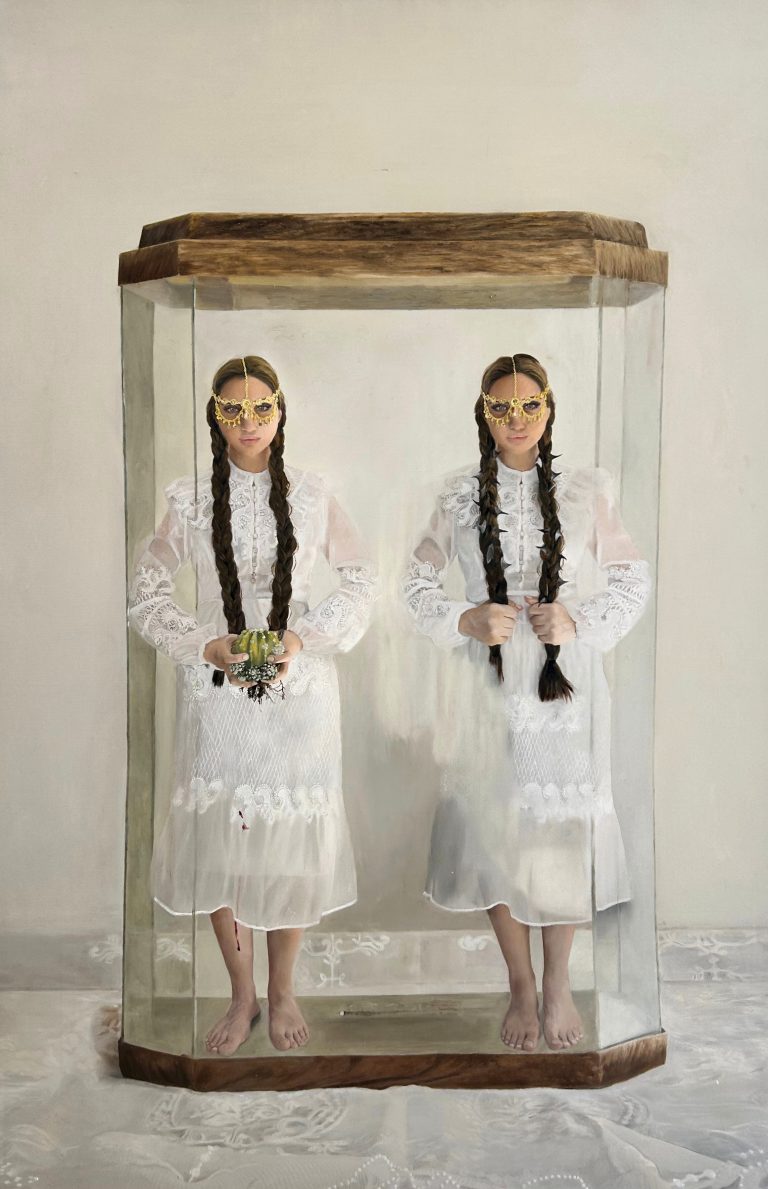Mai Daas’s Ritual Paintings Evoke Knowledge Passed Down Among Women
Mai Daas Challenges the Patriarchy in a New Exhibition
By Avi Pitchon
Haaretz Magazine | 11:21 AM • July 31, 2025
Summary
At a glance, the images on Braverman Gallery’s website might seem like photographs rather than paintings — a result of Mai Daas’s realistic painting style. But upon viewing the works in her exhibition Revelation in person, there’s no room for doubt. Beyond realism, what these paintings depict appears to be documentation of performances, dance pieces, or other kinds of ritualistic, theatrical activity — all set within domestic spaces.
In one painting, eight women stand or kneel in a large room with ornamental tiled flooring and arched, decorated windows and doors. Dressed in white dresses with braided hair — each braid intertwined with her neighbor’s — each woman performs a gesture with her arms and hands, making the scene resemble a dance performance, religious ceremony, or mystical rite. The posture and hand gestures of the woman at the front may evoke Christian iconography for some, or occult symbolism for others.
In another painting, seemingly set in the same room, three women in traditional dresses hold each other’s arms. Each has an apple on her head. They appear to be part of a longer line of women, each turned in the opposite direction from the one next to her. The composition shows the scene from the side — only the middle woman’s face is visible in half profile, while the other two have their backs to us. Unlike the open perspective in the previous painting, this frame is closed off by white walls and doorframes, creating the sensation of peeking into a mysterious scene through glass. This choice enhances the photographic feel, as if documenting an event that really took place.
In a third painting, eight women appear dressed in what look like pale undergarments or matching yoga outfits. They kneel together, foreheads touching the floor, arms stretched backward. Flour is scattered around them, covering their bodies. Is this yoga? Prayer? The scene resembles a moment within a full choreography.
Daas’s feminism doesn’t negate, confront, or clash — it centers on the affirmative power of women as a community.
Other paintings in the exhibition are similarly theatrical and symbol-laden but feature only two or three women. In one exceptional work, a child (likely a girl) is seen from behind, her finger nearly touching the finger of a reclining woman dressed in white, evoking a sacrificial virgin. To the left, another woman sits with a cup, gazing at a small scale before her. A third woman approaches, holding a tray of refreshments. The scene feels tranquil, routine — which, of course, adds to its unsettling tension.
In the only entirely fictional-looking painting, two girls — identical twins or mirrored versions — stand in matching white lace-trimmed dresses with long braids and festive gold eye adornments. One holds a cactus bloom, while the other clutches her own braids, from which large thorns protrude. They stand inside a glass display case, as though exhibited in a creepy folklore show or a surreal anthropological museum.
These detailed descriptions aim to emphasize two things. First, the extent to which Daas has evolved as an artist. In previous years, she painted outdoor scenes or scenes with more blatant and confrontational political and feminist symbolism. Like many artists whose work verges on protest or propaganda, such works often produced predictable results. It’s possible she still paints Palestinian women (Daas is Palestinian, for those wondering) with helicopters above them, cacti, or precarious boulders — but Revelation is an exquisitely cohesive exhibition, both in its content and its bewitching atmosphere.
This leads to the second, equally important point: Daas’s feminism, directed at the patriarchal oppression within her society — expressed through those theatrical, ritualistic indoor scenes — doesn’t rely on negation or confrontation. Instead, it draws all its strength from the affirmative power of women as a collective. These women are not angry, nor are they raising their fists. They use the domestic spaces society assigns them to carry out, seemingly in secret and for themselves (“seemingly,” because they are depicted publicly in paintings), a repertoire of silent, graceful, and enigmatic gestures. These gestures evoke extroverted contemporary art forms (dance, performance), such as the choreographic work of Lilach Pnina Liberman, which blends bodily empowerment with philosophy, psychology, and mysticism. Or conversely, the carnivalesque queerness of “Barbie Kyoot,” the drag persona of choreographer and dancer Hani Sirkis.
These painted scenes also evoke female-led protest actions — from the silent, bowed-head “Handmaid’s Tale” processions during Israel’s judicial overhaul protests to the current white-clad silent demonstrations by women.
Everything curator Adi Gura wrote about the exhibition — regarding community, sisterhood, pain, and resistance — is accurate. It’s all there. But Revelation is much more than that: the fusion of artistic motifs with traditional/ritualistic/uniform garments in each painting, combined with the fact that we, the viewers, don’t truly know what these women are doing behind closed doors, conjures an ancestral feminine knowledge once punishable by death.
In other words, Daas challenges the patriarchy not by pointing out what women under its rule lack, but by powerfully asserting what they do possess. As Gura writes, nothing terrifies oppressors more than “women with bodies, voices, and memory” (think of the powerful Sisterhood in the Dune saga).
What’s the slogan on protest signs again?
“We are the witches you didn’t burn.”
Mai Daas, Revelation.
Curator: Adi Gura
Braverman Gallery (33 Elilat St., Tel Aviv). On view until September 10

Sunday
Monday
Tue – Thu
Friday
Saturday
Closed
By appointment only
11:00 – 18:00
11:00 – 14:00
11:00 – 14:00
Design by The-Studio
Code By Haker Design